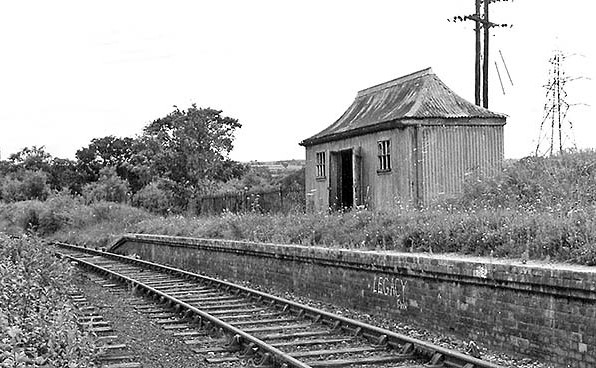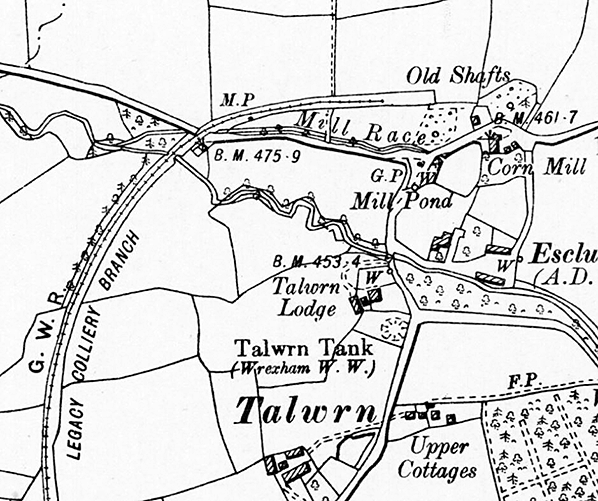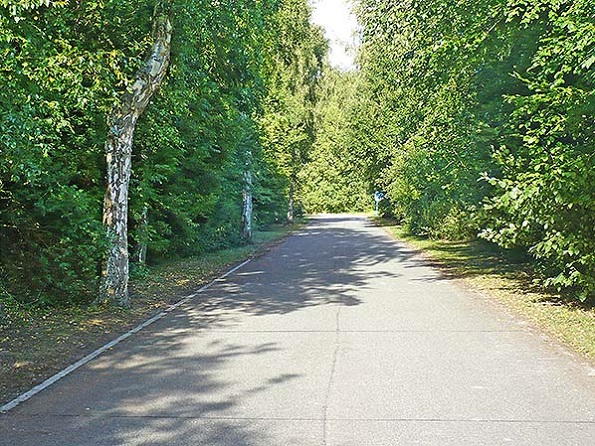|

Legacy station in 1963. Photo from the John Mann collection
On 27 August 1876 the Great Western railway (GWR) opened the 1¼-mile Legacy Branch, a northern extension of the Ponkey Branch which had opened from Gardden Lodge Junction, on the Shreswbury and Chester line, to Ponkey on 1 August 1868. The Legacy branch was built to serve the Legacy Colliery which one historical source states had closed in 1875 after only a 5-year working life. Although there may have been coal stocks at the surface of the Legacy Colliery after closure they cannot have lasted long and so, very shortly after opening the Legacy Branch would have had no purpose. The 6-inch scale OS map of 1898 (see below) shows the northern end of the branch stopping just short of the site of the colliery site (shown as ‘Old Shafts’). It can only be presumed that the line was out of use and had been for many years.

On 14 October 1848 the Shrewsbury and Chester Railway - part of the Great Western Railway (GWR) from 1 September 1854 - had opened and it passed the town of Rhosllanerchrugog about a mile and a half to the east. For the residents of the town that was not close enough and they wanted the GWR to build a branch to serve them more conveniently. The London & North Western Railway (LNWR) built a railway to Rhosllanerchrugog (an extension to its Pontcysyllte Branch) which opened in January 1867 but it was a goods line only. In the mid 1890s, frustrated by the absence of railway access, the residents of Rhosllanerchrugog formed the East Denbighshire Railway (EDR). The EDR proposed a line from Wrexham Central (on Wrexham, Mold & Connahs Quay Railway) to Rhosllanerchrugog and beyond towards the Vale of Llangollen. The creation of the EDR spurred the GWR into action and it was able to kill off the EDR by proposing to build the 3¾-mile Rhos branch, which received Royal Assent on 6 August 1897. The line extended from Rhos Junction (to the north on the Shrewsbury and Chester line) to an end-on junction with the Pontcysyllte Branch at Rhosllanerchrugog (shortened to Rhos by the GWR). The Legacy Branch featured in the plans as it was to form a junction with the Rhos Branch giving the GWR a connection to the Ponkey Branch from the north and forming a bypass loop line to the west of the Shrewsbury and Chester main line.
An approximately 8-chain section of the Legacy Branch was actually used to form part of the Rhos Branch and it was on this stretch of the line that Legacy station would be located. The Bronwylfa Road crossed the line by means of a level crossing and the junction between the two branches was formed on the western side of the crossing. The station was located west of the crossing in a somewhat isolated location to the north of Talwrn; it was probably located here only because of the existence of the junction.
The station was provided with a single platform on the north side of the line. The station building containing the usual passenger facilities was a much smaller version of a standard GWR design seen at many of its stations (including Rhos and Rhostyllen) which were opened or improved circa 1900. The structure was of brick with beneath a hipped slate roof. A canopy extended the length of the building and full width of the platform and carried a saw-tooth, pierced valance. This feature, too, was the standard for GWR stations of the time.At some point a GWR corrugated iron ‘pagoda’ waiting shelter was added. There was a passing loop at Legacy and a siding with loading ramp.
At the time of opening there was a small ground-level signal box with a 9-lever NK-Type frame. The 9 levers must have controlled the points and signals associated with the junction. It was replaced in 1905 with a GWR Type 28 (all wood) box with a 23-lever NK-Type frame located west of the station adjacent to the level crossing. The new box was most probably required as part of the upgrading of the Legacy Branch for passenger working. A 1949 photograph shows a fine signal gantry at the western end of the station platform which carried two Home signals, one for each of the two branches. Interestingly, it appears from the photo that the branches were given equal status as both signal arms seem to have been positioned at the same height (the Legacy Branch signal arm is missing in the 1949 photo as that branch had closed).
From 1 October 1901 a passenger service was operated between Wrexham General and Rhos and although the station was not listed as being able to handle passengers by the RCH 1904 Handbook of stations Quick cites a minute from the Railway Clearing House Goods Managers’ conference that states, tantalizingly, ‘drop station for passengers’. There were four passenger trains per day each way, with two extra services on Thursday and Saturday. Two goods trains also ran each weekday and they would definitely have served Legacy. No trains ran on the line on Sunday.
To counter competition from a local tramway operator the GWR introduced a rail-motor service onto the Rhos branch on 1 May 1905. Three new halts were opened on the Pontcysyllte Branch (south of Rhos) and the passenger service was extended to the southernmost of them, Wynn Hall Halt. From 5 June 1905 three more halts opened on the Legacy/Ponkey branch and services began operating between Ponkey Crossing Halt and Wrexham General. With the introduction of the rail-motor service there is no doubt regarding the status of Legacy station in terms of it handling passengers as it is listed in the timetables. It is possible that it was at this time that the pagoda shelter was added.
The November 1906 timetable (click here to see it) showed Legacy as having 16 trains to Wrexham General on Monday-to-Friday and 17 on Saturday. There were also 16 trains in the opposite direction on Monday-to-Friday but on Saturday there were 18. Of the 16 Monday-to-Friday southbound trains 12 were advertised as going to Ponkey Crossing Halt, 10 to Wynn Hall Halt and two to Rhos. The disparity is due to a number of the southbound services operating both to Ponkey Crossing Halt and Wynn Hall Halt. This could have been achieved by running two rail-motors in tandem and splitting them at Legacy or by the running of a shuttle between Legacy and Ponkey Crossing Halt. As there was only one platform at Legacy, and it was certainly long enough, the former seems to be the more likely. The journey time between Ponkey Crossing Halt and Legacy was only 5 minutes, and there were calls at two intermediate halts; Rhos to Legacy was a 4-minute journey. On weekdays there was a Wrexham General departure from Ponkey Crossing Halt at 9.35am that would have arrived at Legacy at 9.40am. At 9.40am another Wrexham General rail-motor departed from Rhos and it reached Legacy at 9.44am. The onward departure time from Legacy is given as 9.45am. If the Ponkey Crossing service ran as a shuttle it would have to drop off its passengers and then move off the main line within 4 minutes. That would have been very difficult to achieve. One minute for the rail-motors to couple together was also quite a feat but with skilled railwaymen it could be done.
The rail-motor service was remarkably intensive for branches with relatively little population adjacent to them. Rhos and Johnstown (the latter being served by the halts on the Ponkey Legacy/Branch) had the largest populations and it is likely that the rail-motors picked up most of their business at those locations. It is doubtful that much passenger revenue would have been generated at Legacy but it would have seen periods of intense activity when the services from the Rhos and Legacy/Ponkey Branches converged (especially with the splitting activity). Legacy station would also have seen busy periods of shunting activity at this time. Wagons from Rhostyllen (the next station to the north) for Wrexham had first to be brought to Legacy as there was no run-round loop there; they would need to be placed into the siding and await a returning train to which they would be attached.
In 1912 motor-bus services were introduced to the surrounding area and they successfully competed with the rail-motor service. On 22 March 1915, with revenue dwindling, the passenger services between Rhos and Wynn Hall Halt and between Legacy and Ponkey Crossing Halt were withdrawn and the halts were all closed. Passenger services reverted to operating only between Rhos and Wrexham General and Legacy continued to be served. The withdrawal of the service to Ponkey Crossing Halt meant that the northern section of the Legacy branch had no purpose. It was closed between Legacy and the site of Aberderfyn Halt and the track was lifted in 1917, except for a short stub at Legacy that became a siding.
The July 1922 timetable showed that Legacy had 13 trains in each direction on Monday-to-Friday with an extra four trains each way on Saturday. This was a generous level of service for a station in such an isolated location. There are suggestions that the passenger facilities at Legacy were unstaffed by this time which seems likely. References have been seen to the station as ‘Legacy Halt’.
On 1 January 1931 the passenger service between Rhos and Wrexham was withdrawn.
The goods siding at Legacy continued to be used and sometime around 1934 it gained additional traffic associated with the Wrexham & East Denbighshire Water Company which had established an aqueduct; an associated water tower and service depot were adjacent to the line.
Legacy station became part of British Railways on 1 January 1948 and by that time the Central Electricity Generating Board had established a facility adjacent to the line; the stub of the Legacy Branch became a siding used for the delivery of stores.
The signal box closed in 1952 and from that date the sidings would have been worked by hand by members of the train crews.
The 1956 RCH Handbook of stations listed Legacy as being able to handle general goods, parcels and miscellaneous traffic and the siding serving the Central Electricity Generating Board is also listed.
The line was closed to all traffic by British Railways on 14 October 1963. Whilst Legacy was listed as being still open for goods services it seems unlikely that it was doing so towards the end as a photo taken in 1963 shows the sidings to be very overgrown. Track-lifting on the branch commenced in July 1964.
 The site of Legacy station looking west on 3 August 2015. Photo by Paul Wright The site of Legacy station looking west on 3 August 2015. Photo by Paul Wright
|

 Home
Page
Home
Page

 Home
Page
Home
Page